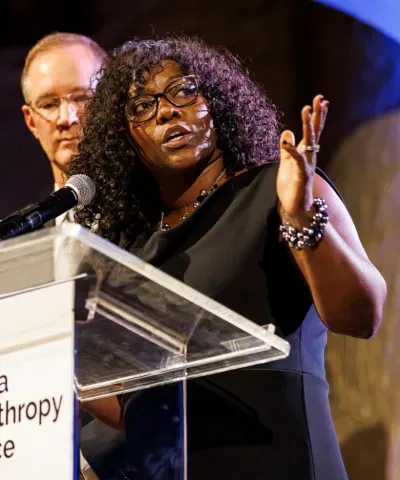Being Genuinely Human: A Skill AI Can’t Duplicate
Authentic storytelling is philanthropy’s most essential human skill and one that no technology or AI can replace.

Let’s be honest: being a human is weird.
We laugh at the wrong times, cry at commercials about puppies, and get misty-eyed seeing kids making mud pies at the local park. We argue with GPS systems as if they can hear us, and we swell up with pride when our alma mater hoists the state basketball trophy in Indianapolis.
It’s because as humans, we’re emotional, unpredictable, and sometimes a little neurotic.
But that’s the magic.
Look, machines can calculate, predict, and optimize – but they can’t feel. They can’t understand why a grandmother in southern Indiana would bake three pies for a church fundraiser just to make sure nobody left hungry. That’s a human story, and it’s in those stories where philanthropy finds its deepest meaning.
During a recent session of our Mutz Philanthropic Leadership Institute, our cohort discussed the timeless power of storytelling. Stories – real stories – carry a weight that numbers and mission statements alone cannot hold. They spark emotion, build connection, and provide the clearest picture of why organizations exist in the first place.
No matter how much the world changes, the art of storytelling will never lose its relevance.
This is especially true in small-town Indiana. We belong to a state where connections run deep: where people know one another not only by name, but through neighbors, schools, churches, and community traditions.
In this kind of environment, stories spread quickly, and they stick. When a nonprofit organization shines a light on a donor, a local partner, or a person whose life has been transformed by its work, that story often travels further than the organization could ever reach with marketing dollars alone.
The reason is simple: these stories are rooted in truth. They are based on hard work, perseverance, and results that can be seen and felt in daily life. When a nonprofit shares the journey of a local family gaining access to fresh produce for the first time, or a student who can now thrive in school thanks to access to proper healthcare and hygiene tools, the story does more than showcase impact. It reflects the heart of the organization – its mission carried out in human form.
And those stories last. A donor may not be able to recall a neatly polished mission statement word-for-word, but they will remember a grandmother who is raising her grandchildren with newfound stability thanks to a local grant. A board member may struggle to recite financial statistics, but they can share a vivid account of the after-school program that helped a young boy find confidence, direction, and belonging. These are the kinds of images that anchor people to an organization’s purpose.
Impactful storytelling will always have a place
In philanthropy, stories with “emotional teeth” create staying power. They reach beyond the head and into the heart, reminding us why charitable giving matters. They are also what inspire others to take part. When we hear a neighbor’s story of resilience, we are more likely to believe in the possibility of change for our community as well.
What makes storytelling particularly irreplaceable is its humanity. At its core, storytelling is not just about words on a page – it’s about presence, empathy, and listening. It requires sitting down across from someone, hearing their challenges and triumphs, and honoring them with dignity. It is a process built on trust and shared humanity.
That is something technology cannot replicate. An algorithm cannot sit in a church basement and hear from a mother who now cooks fresh meals for her children after years of relying on packaged foods. A machine cannot fully capture the pride of a father watching his son with special needs play with his classmates for the first time thanks to an all-inclusive playground. These are moments thick with emotion, and they demand a human touch to properly experience and retell with accuracy and care.
The strength of Indiana philanthropy lies in its people. Whether through donor generosity, nonprofit dedication, or community resilience, the stories that emerge here are uniquely personal and deeply human. To tell them well requires a skill that is both ancient and enduring: the ability to connect one person’s life to the hopes of many.
Indiana philanthropy is about more than just metrics; it’s about leaning into meaningful connections. Where front porches facilitate neighborhood conversations and local diners serve as informal town halls, storytelling is not merely a tool but a deeply rooted tradition. It’s how we, as a community, pass down our values, celebrate milestones, and face challenges together.
When we embrace this tradition, we elevate our efforts from being merely transactional to truly transformative. A grant is not just a line item; it represents the opportunity for a young artist to host her first gallery show or for a high school student to launch his business idea through an entrepreneurial program at school. These experiences foster hands-on learning, build confidence, and teach individuals how to turn ideas into impactful realities.
While technology can help us organize, amplify, and analyze, it cannot replace the fundamental human instinct to care, listen, and feel. It cannot replicate the tears of someone sharing their journey from hardship to success and security, nor the pride of volunteers who show up every week to contribute to the community.
Storytelling should be central to our philanthropic efforts; it is the foundation of our work, not an afterthought. Through storytelling, we maintain our connection to our mission, remind ourselves of our reasons for starting, invite others to join us, and ensure that our work is truly representative of those we serve in the community.
The future of storytelling is inherently human
When we bring these insights together, the conclusion is clear: in philanthropy, being human is not just helpful – it is essential.
Nonprofits may rely on tools and strategies to share their mission, but the stories that endure are the ones told with compassion and lived experience.
Storytelling allows us to move beyond abstract visions and into the heart of what philanthropy is all about: people helping people. It ensures that when we speak of generosity in Indiana, we are not speaking of vague ideas, but of neighbors whose lives are brighter and stronger because someone cared enough to listen and share.
And in the end, that is why storytelling will never grow old. It is not only the best kind of marketing – it is the purest form of connection we have.

This article was written by a Mutz Philanthropic Leadership Institute class member. The institute is focused on building Indiana’s talent pipeline of senior professionals and board members within foundations and corporate giving programs.
explore the mutz institute




